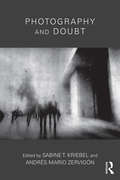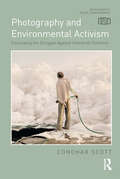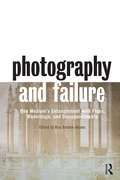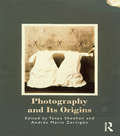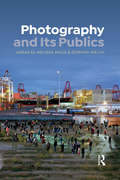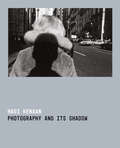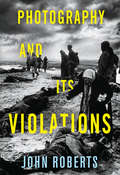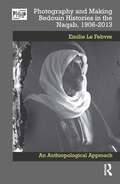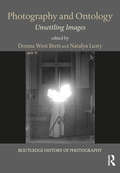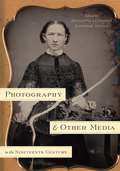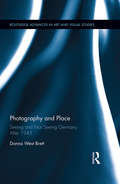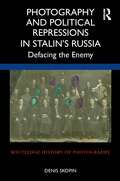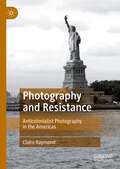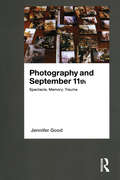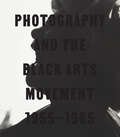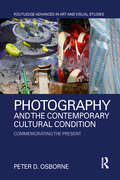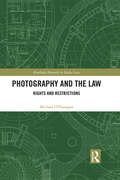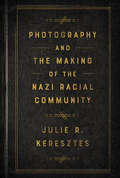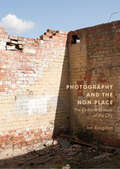- Table View
- List View
Photography and Doubt
by Sabine T. Kriebel Andrés Mario ZervigónRecent decades have seen photography’s privileged relationship to the real come under question. Spurred by the postmodern critique of photography in the 1980s and the rise of digital technologies soon thereafter, scholars have been asking who and what built this understanding of the medium in the first place. Photography and Doubt reflects on this interest in photography’s referential power by discussing it in rigorously historical terms. How was the understanding of photographic realism cultivated in the first place? What do cases of staged and manipulated photography reveal about that realism’s hold on audiences across the medium’s history? Have doubts about photography’s testimonial power stimulated as much knowledge as its realism? Edited by Sabine T. Kriebel and Andrés Mario Zervigón, Photography and Doubt is the first multi-authored collection specifically designed to explore these questions. Its 13 original essays, illustrated with 73 color images, explore cases when the link between the photographic image and its referent was placed under stress, and when photography was as attuned to its myth-making capabilities as to its claims to authenticity. Photography and Doubt will serve as a valuable resource for students and scholars in art history, visual and media studies, philosophy, and the history of science and technology.
Photography and Environmental Activism: Visualising the Struggle Against Industrial Pollution (Photography, Place, Environment)
by Conohar ScottThis publication maps out key moments in the history of environmentalist photography, while also examining contemporary examples of artistic practice. Historically, photography has acted as a technology for documenting the industrial transformation of the world around us; usually to benefit the interests of capitalist markets. An alternative photographic tradition exists, however, in which the indexical image is used 'evidentially' to protest against incidents of industrial pollution. By providing a definition of environmental activism in photographic praxis, and identifying influential practitioners, this publication demonstrates that photography plays a vital role in the struggle against environmental despoliation. This book will be of interest to scholars in photography, art and visual culture, environmental humanities, and the history of photography.
Photography and Failure: One Medium's Entanglement with Flops, Underdogs and Disappointments
by Kris Belden-AdamsThroughout photography’s history, failure has played an essential, recurring part in the development and perceived value of this medium. Exploring a range of failures – individual and institutional, technological and historiographical – Photography and Failure asks what it means to fail and considers how this narrative of failure has shaped our understanding of photography. From the trial-and-error beginnings of photochemistry to poor business decisions influenced by fickle public opinion and taste, the founders and early practitioners of photography frequently faced bankruptcy and ignominy. Alongside these individual ‘failures’, this collection of essays examines the role of museums in rediscovering, preserving and presenting photographs within institutions, as well as technological limitations, such as the problematic panoramic lens or the digital, archival failures of Snapchat. Moving beyond the physical photograph and these processes, the book also investigates the limitations of photographs themselves, as purveyors of truth, time, space, documentary realism and social change, whether these failures are used to effect or not. Finally, the book probes the historiographical failures affecting the discipline, drawing on key debates, such as the perceived over-emphasis on European and American photography, and the place of photography theory in contemporary art practice. Blurring the boundaries between traditional binaries of art and non-art photography, amateur and professional practice, and individual and corporate perspectives, Photography and Failure presents a new approach to understanding and evaluating photographic history.
Photography and Imagination (Routledge History of Photography)
by Amos Morris-Reich Margaret OlinAs the prototypical exemplar of modern visual technology, photography was once viewed as a way to enable vision to bypass imagination, producing more reliable representations of reality. But as an achievement of technological modernity, photography can also be seen as a way to realize a creation of the imagination more vividly than can painting or drawing. Photography and Imagination investigates, from diverse points of view focusing on both theory and practice, the relation between these two terms. The book explores their effect on photography’s capacity, through various forms and modalities of imaginative investments and displacements, to affect even reality itself.
Photography and Its Origins
by Tanya Sheehan Andres ZervigonRecent decades have seen a flourishing interest in and speculation about the origins of photography. Spurred by rediscoveries of ‘first’ photographs and proclamations of photography’s death in the digital age, scholars have been rethinking who and what invented the medium. Photography and Its Origins reflects on this interest in photography’s beginnings by reframing it in critical and specifically historiographical terms. How and why do we write about the origins of the medium? Whom or what do we rely on to construct those narratives? What’s at stake in choosing to tell stories of photography’s genesis in one way or another? And what kind of work can those stories do? Edited by Tanya Sheehan and Andrés Mario Zervigón, this collection of 16 original essays, illustrated with 32 colour images, showcases prominent and emerging voices in the field of photography studies. Their research cuts across disciplines and methodologies, shedding new light on old questions about histories and their writing. Photography and Its Origins will serve as a valuable resource for students and scholars in art history, visual and media studies, and the history of science and technology.
Photography and Its Publics
by Melissa Miles; Edward WelchPhotography is a ubiquitous part of the public sphere. Yet we rarely stop to think about the important role that photography plays in helping to define what and who constitute the public. Photography and Its Publics brings together leading experts and emerging thinkers to consider the special role of photography in shaping how the public is addressed, seen and represented.This book responds to a growing body of recent scholarship and flourishing interest in photography's connections to the law, society, culture, politics, social change, the media and visual ethics.Photography and Its Publics presents the public sphere as a vibrant setting where these realms are produced, contested and entwined. Public spheres involve yet exceed the limits of families, interest groups, identities and communities. They are dynamic realms of visibility, discussion, reflection and possible conflict among strangers of different race, age, gender, social and economic status. Through studies of photography in South America, North America, Europe and Australasia, the contributors consider how photography has changed the way we understand and locate the public sphere. As they address key themes including the referential and imaginative qualities of photography, the transnational circulation of photographs, online publics, social change, violence, conflict and the ethics of spectatorship, the authors provide new insight into photography's vital role in defining public life.
Photography and Its Shadow
by Hagi KenaanPhotography and Its Shadow argues that the invention of photography marked a rupture in our relation to the world and what we see in it. The dominant theoretical and artistic paradigm for understanding the invention has been the tracing of shadows. But what photography really inaugurated was the shadow's disappearance—a disappearance that irreversibly changed our relationship to nature and the real, to time and to death. A way of negotiating impermanence, photography was marked from the start by an inherent contradiction. It conflated two incompatible configurations of the visible: an embodied human eye, deeply sensitive to nature, and a machine vision that aimed to reify the instant and wallow in images alone. Photography's history is replete with efforts to conceal the mystery of its paradoxical constitution. Born in the century of Nietzsche's "death of God," it long enacted the fraught subjectivity of its age. Anxious, haunted by a void, it used an array of strategies to take on ever-new identities. Challenging the hitherto most influential accounts of the practice and taking us from its origins to the present, Hagi Kenaan shows us how photography has been transformed over time, and how it transforms us.
Photography and Its Violations
by John RobertsA passionate defense of the medium's truth-telling powers.
Photography and Its Violations (Columbia Themes in Philosophy, Social Criticism, and the Arts)
by John RobertsTheorists critique photography for "objectifying" its subjects and manipulating appearances for the sake of art. In this bold counterargument, John Roberts recasts photography's violating powers of disclosure and aesthetic technique as part of a complex "social ontology" that exposes the hierarchies, divisions, and exclusions behind appearances.The photographer must "arrive unannounced" and "get in the way of the world," Roberts argues, committing photography to the truth-claims of the spectator over the self-interests and sensitivities of the subject. Yet even though the violating capacity of the photograph results from external power relations, the photographer is still faced with an ethical choice: whether to advance photography's truth-claims on the basis of these powers or to diminish or veil these powers to protect the integrity of the subject. Photography's acts of intrusion and destabilization, then, constantly test the photographer at the point of production, in the darkroom, and at the computer, especially in our 24-hour digital image culture. In this game-changing work, Roberts refunctions photography's place in the world, politically and theoretically restoring its reputation as a truth-producing medium.
Photography and Jewish History: Five Twentieth-Century Cases (Jewish Culture and Contexts)
by Amos Morris-ReichIt is a sign of the accepted evidentiary status of photographs that historians regularly append them to their accounts, Amos Morris-Reich observes. Very often, however, these photographs are treated as mere illustrations, simple documentations of the events that transpired. Scholars of photography, on the other hand, tend to prioritize the photographs themselves, relegating the historical contexts to the background. For Morris-Reich, however, photography exists within reality; it partakes in and is very much a component of the history it records. Morris-Reich examines how photography affects categories of history and experience, how it is influenced by them, and the ways in which our understanding of the relationship between history and photography can be theorized and reoriented.Morris-Reich here turns to five twentieth-century cases in which photography and Jewish history intersect: Albert Kahn’s utopian attempt to establish a photographic archive in Paris in order to advance world peace; the spectacular failed project of Helmar Lerski, the most prominent photographer in British Mandate Jewish Palestine; photography in the long career of Eugen Fischer, a Nazi professor of genetics; the street photography of Robert Frank; and the first attempt to introduce photography into the study of Russian Jewry prior to World War I, as seen from the post-Holocaust perspective of the early twenty-first century. Illustrated with nearly 100 images, Photography and Jewish History moves beyond a focus on Jewish photographers or the photographic representation of Jews or Jewish visibility to plumb the deeper and more significant registers of twentieth-century Jewish political history.
Photography and Making Bedouin Histories in the Naqab, 1906-2013: An Anthropological Approach (Photography, History: History, Photography)
by Emilie Le FebvreIntroducing a novel anthropological study of photography in the Middle East, Emilie Le Febvre takes us to the Naqab Desert where Bedouin use photographs to make, and respond to, their own histories. She argues Bedouin presentations of the past are selective but increasingly reliant on archival documents such as photographs which spokespersons treat as evidence of their local histories amid escalating tensions in Israel. These practices shape Bedouin visual historicity, that is the diverse ways people produce their pasts in the present with images. This book charts these processes through the afterlives of six photographs (c. 1906–2013) as they circulate between the Naqab’s entangled visual economies – a transregional landscape organised by cultural ideals of proximity and assemblages of Bedouin iconography. Le Febvre illustrates how representational contentions associated with tribal, civic, and Palestinian-Israeli politics influence how images do history work in this society. She concludes Bedouin visual historicity is defined by acts of persuasion during which photographs authenticate alternating history projects. Here, Bedouin value photographs not because they evidence singular narratives of the past. Rather, the knowledges inscribed by photography are multifarious as they support diverse constructions of history and society with which members mediate a wide range of relationships in southern Israel. This book bridges studies of anthropology, photography, Palestinian-Israeli politics, and Bedouin Middle East history.
Photography and Ontology: Unsettling Images (Routledge History of Photography)
by Natalya Lusty Donna West BrettThis edited collection explores the complex ways in which photography is used and interpreted: as a record of evidence, as a form of communication, as a means of social and political provocation, as a mode of surveillance, as a narrative of the self, and as an art form. What makes photographic images unsettling and how do the re-uses and interpretations of photographic images unsettle the self-evident reality of the visual field? Taking up these themes, this book examines the role of photography as a revelatory medium underscored by its complex association with history, memory, experience and identity.
Photography and Other Media in the Nineteenth Century
by Simone Natale Nicoletta LeonardiIn this volume, leading scholars of photography and media examine photography’s vital role in the evolution of media and communication in the nineteenth century.In the first half of the nineteenth century, the introduction of telegraphy, the development of a cheaper and more reliable postal service, the rise of the mass-circulation press, and the emergence of the railway dramatically changed the way people communicated and experienced time and space. Concurrently, photography developed as a medium that changed how images were produced and circulated. Yet, for the most part, photography of the era is studied outside the field of media history. The contributors to this volume challenge those established disciplinary boundaries as they programmatically explore the intersections of photography and “new media” during a period of fast-paced change. Their essays look at the emergence and early history of photography in the context of broader changes in the history of communications; the role of the nascent photographic press in photography’s infancy; and the development of photographic techniques as part of a broader media culture that included the mass-consumed novel, sound recording, and cinema.Featuring essays by noteworthy historians in photography and media history, this discipline-shifting examination of the communication revolution of the nineteenth century is an essential addition to the field of media studies.In addition to the editors, contributors to this volume are Geoffrey Batchen, Geoffrey Belknap, Lynn Berger, Jan von Brevern, Anthony Enns, André Gaudreault, Lisa Gitelman, David Henkin, Erkki Huhtamo, Philippe Marion, Peppino Ortoleva, Steffen Siegel, Richard Taws, and Kim Timby.
Photography and Other Media in the Nineteenth Century
by Nicoletta Leonardi and Simone NataleIn this volume, leading scholars of photography and media examine photography’s vital role in the evolution of media and communication in the nineteenth century.In the first half of the nineteenth century, the introduction of telegraphy, the development of a cheaper and more reliable postal service, the rise of the mass-circulation press, and the emergence of the railway dramatically changed the way people communicated and experienced time and space. Concurrently, photography developed as a medium that changed how images were produced and circulated. Yet, for the most part, photography of the era is studied outside the field of media history. The contributors to this volume challenge those established disciplinary boundaries as they programmatically explore the intersections of photography and “new media” during a period of fast-paced change. Their essays look at the emergence and early history of photography in the context of broader changes in the history of communications; the role of the nascent photographic press in photography’s infancy; and the development of photographic techniques as part of a broader media culture that included the mass-consumed novel, sound recording, and cinema.Featuring essays by noteworthy historians in photography and media history, this discipline-shifting examination of the communication revolution of the nineteenth century is an essential addition to the field of media studies.In addition to the editors, contributors to this volume are Geoffrey Batchen, Geoffrey Belknap, Lynn Berger, Jan von Brevern, Anthony Enns, André Gaudreault, Lisa Gitelman, David Henkin, Erkki Huhtamo, Philippe Marion, Peppino Ortoleva, Steffen Siegel, Richard Taws, and Kim Timby.
Photography and Place: Seeing and Not Seeing Germany After 1945 (Routledge Advances in Art and Visual Studies)
by Donna West BrettAs a recording device, photography plays a unique role in how we remember places and events that happened there. This includes recording events as they happen, or recording places where something occurred before the photograph was taken, commonly referred to as aftermath photography. This book presents a theoretical and historical analysis of German photography of place after 1945. It analyses how major historical ruptures in twentieth-century Germany and associated places of trauma, memory and history affected the visual field and the circumstances of looking. These ruptures are used to generate a new reading of postwar German photography of place. The analysis includes original research on world-renowned German photographers such as Thomas Struth, Thomas Demand, Michael Schmidt, Boris Becker and Thomas Ruff as well as photographers largely unknown in the Anglophone world.
Photography and Political Repressions in Stalin’s Russia: Defacing the Enemy (Routledge History of Photography)
by Denis SkopinThis book is devoted to the phenomenon of removal of people declared "public enemies" from group photographs in Stalin’s Russia. The book is based on long-term empirical research in Russian archives and includes 57 photographs that are exceptional in terms of historical interest: all these images bear traces of editing in the form of various marks, such as blacking-out, excisions or scratches. The illustrative materials also include a group of photographs with inscriptions left by officers of Stalin’s secret police, the NKVD. To approach this extensive visual material, Denis Skopin draws on a wealth of Stalin-era written sources: memoirs, diaries and official documents. He argues that this kind of political iconoclasm cannot be confused with censorship nor vandalism. The practice in question is more harrowing and morally twisted, for in most cases the photos were defaced by those who were part of victim’s intimate circle: his/her colleagues, friends or even close family members. The book will be of interest to scholars working in history of photography, art history, visual culture, Russian studies and Russian history and politics.
Photography and Resistance: Anticolonialist Photography in the Americas
by Claire RaymondThis book argues that photography, with its inherent connection to the embodied material world and its ease of transmissibility, operates as an implicitly political medium. It makes the case that the right to see is fundamental to the right to be. Limning the paradoxical links between photography as a medium and the conditions of political, social, and epistemological disappearance, the book interprets works by African American, Indigenous American, Latinx, and Asian American photographers as acts of political activism in the contemporary idiom. Placing photographic praxis at the crux of 21st-century crises of political equity and sociality, the book uncovers the discursive visual movements through which photography enacts reappearances, bringing to visibility erased and elided histories in the Americas. Artists discussed in-depth include Shelley Niro, Carrie Mae Weems, Paula Luttringer, LaToya Ruby Frazier, Matika Wilbur, Martine Gutiérrez, Ana Mendieta, An-My Lê, and Rebecca Belmore. The book makes visible the American land as a site of contestation, an as-yet not fully recognized battlefield.
Photography and September 11th: Spectacle, Memory, Trauma
by Jennifer GoodIt is all but impossible to think of September 11th 2001 and not, at the same time, recall an image. The overwhelmingly visual coverage in the world's media pictured a spectacle of terror, from images of the collapsing towers, to injured victims and fatigued firefighters. In the days, weeks and months that followed, this vast collection of photographs continued to circulate relentlessly. This book investigates the psychological impact of those photographs on a stunned American audience. Drawing on trauma theory, this book asks whether the prolonged exposure of audience to photographs was cathartic or damaging. It explores how first the collective memory of the event was established in the American psyche and then argues that through repetitive use of the most powerful pictures, the culture industry created a dangerously simple 9/11 metanarrative. At the same time, people began to reclaim and use photography to process their own feelings, most significantly in 'communities' of photographic memorial websites. Such exercises were widely perceived as democratic and an aid to recovery. This book interrogates that assumption, providing a new understanding of how audiences see and process news photography in times of crisis.
Photography and Surrealism: Sexuality, Colonialism and Social Dissent
by David BateDavid Bate examines automatism and the photographic image, the Surrealist passion for insanity, ambivalent use of Orientalism, use of Sadean philosophy and the effect of fascism of the Surrealists. The book is illustrated wtih a wide range of surrealist photographs.
Photography and the Art of Chance
by Robin KelseyAs anyone who has wielded a camera knows, photography has a unique relationship to chance. It also represents a struggle to reconcile aesthetic aspiration with a mechanical process. Robin Kelsey reveals how daring innovators expanded the aesthetic limits of photography in order to create art for a modern world.
Photography and the Black Arts Movement, 1955-1985
by Angela Davis Sarah Lewis Margo Natalie Crawford Makeda Best Cheryl Finley Romi Crawford Audrey SandsFeaturing more than 100 artists, this landmark book charts the intricate connections between photography and the Black Arts Movement The Black Arts Movement brought together writers, filmmakers, and visual artists who were exploring ways of using art to advance civil rights and Black self-determination. This book examines the vital role of photography in the evolution of the Black Arts Movement, revealing how photographs operated across art, community building, journalism, and political messaging to contribute to the development of a distinctly Black art and culture. Works by Romare Bearden, Dawoud Bey, Kwame Brathwaite, Samuel Fosso, Jeanne Moutoussamy-Ashe, Gordon Parks, Juan Sánchez, Robert A. Sengstacke, Lorna Simpson, Ming Smith, and Carrie Mae Weems, among dozens of other celebrated and underappreciated artists, span documentary and fashion photography, portraiture, collage, installation, performance, and video. Pictured luminaries include Miles Davis, Mahalia Jackson, Martin Luther King, Jr., Bob Marley, Nina Simone, Malcolm X, and many more. The book&’s essays by distinguished scholars focus on topics such as women and the movement, community, activism, and Black photojournalism. Taking an expansive approach, the authors consider the complex connections between American artists and the African diaspora and the dynamic interchange of pan-African ideas that propelled the movement. Authoritative and beautifully illustrated, this is the definitive volume on photography and the Black Arts Movement. Published in association with the National Gallery of Art, Washington Exhibition Schedule: National Gallery of Art, Washington, DC (September 21, 2025–January 4, 2026) J. Paul Getty Museum, Los Angeles, CA (February 24–May 24, 2026) Mississippi Museum of Art, Jackson, MS (July 25–November 1, 2026)
Photography and the Contemporary Cultural Condition: Commemorating the Present (Routledge Advances in Art and Visual Studies)
by Peter D. OsborneIn this book, Osborne demonstrates why and how photography as photography has survived and flourished since the rise of digital processes, when many anticipated its dissolution into a generalised system of audio-visual representations or its collapse under the relentless overload of digital imagery. He examines how photography embodies, contributes to, and even in effect critiques how the contemporary social world is now imagined, how it is made present and how the concept and the experience of the Present itself is produced. Osborne bases his discussions primarily in cultural studies and visual cultural studies. Through an analysis of different kinds of photographic work in distinct contexts, he demonstrates how aspects of photography that once appeared to make it vulnerable to redundancy turn out to be the basis of its survival and have been utilised by much important photographic work of the last three decades.
Photography and the Law: Rights and Restrictions (Routledge Research in Media Law)
by Michael O’FlanaganPhotographers and publishers of photographs enjoy a wide range of legal rights including freedom of expression and of publication. They have a right to create and publish photographs. They may invoke their intellectual, moral and property rights to protect and enforce their rights in their created and/or published works. These rights are not absolute. This book analyses the various legal restrictions and prohibitions, which may affect these rights. Photography and the Law investigates the legal limitations faced by professional and amateur photographers and photograph publishers under Irish, UK and EU Law. Through an in-depth discussion of the personal rights of the public, including the right not to be harassed, the book gives a clear analysis of the current legal standpoint on the relationship between privacy and freedom of expression. Additionally, the book looks at the reconciliation of photographers’ rights with the state’s interest in public security and defence, alongside the enforcement of ethical and moral codes. Comparative legal standing in the European Union is used as a springboard to further analyse Irish and UK statutes and case law, including recent reforms and current proposals for future change. The book ends with pertinent suggestions of the necessary reforms and enactments required to rebalance the relationship between the personal rights of individuals, the state’s duties and the protection of photographers’ and photograph publishers’ rights. By clearly explaining the theoretical and conceptual reasoning behind the current law, alongside proposed reforms, the book will be a useful tool for any student or academic interested in photography law, privacy and media law, alongside professional and amateur photographers and photograph publishers.
Photography and the Making of the Nazi Racial Community
by Julie R. KeresztesPhotography and the Making of the Nazi Racial Community examines the role of photography in the construction of the Nazi Volksgemeinschaft, a racially exclusive community, during the Third Reich. Julie R. Keresztes explores how the dictatorship promoted photography for those who belonged to that community and excluded Jews from the practice. As Nazi officials dispossessed Jewish photographers and robbed them of their equipment, studios, and eventually their lives, they made photography more accessible to non-Jewish Germans. But they inadvertently created spaces for photography to be used as resistance and revenge in concentration camps, where forced laborers salvaged photographs that exposed the extermination of Europe's Jews. As the victims of Nazi persecution used photography to gather evidence of the Holocaust, German troops and their families used photography to portray themselves as dutiful members of the Volksgemeinschaft rather than show the reality of war and genocide. Ultimately, Photography and the Making of the Nazi Racial Community shows how the configuration of photography along racial lines shaped the imagery of the Second World War.Published in Association with the US Holocaust Memorial Museum.
Photography and the Non-Place: The Cultural Erasure Of The City
by Jim BrogdenThis book presents a critical and aesthetic defence of “non-place” as an act of cultural reclamation. Through the restorative properties of photography, it re-conceptualises the cultural significance of non-place. The non-place is often referred to as “wasteland”, and is usually avoided. The sites investigated in this book are located where access and ownership are often ambiguous or in dispute; they are places of cultural forgetting. Drawing on the author’s own photographic research-led practice, as well as material from photographers such as Ed Ruscha, Joel Sternfeld and Richard Misrach, this study employs a deliberately allusive intertexuality to offer a unique insight into the contested notions surrounding landscape representation. Ultimately, it argues that the non-place has the potential to reveal a version of England that raises questions about identity, loss, memory, landscape valorisation, and, perhaps most importantly, how we are to arrive at a more meaningful place.
